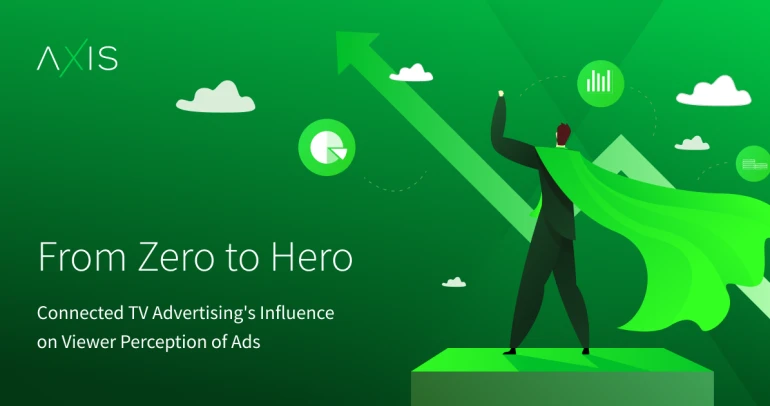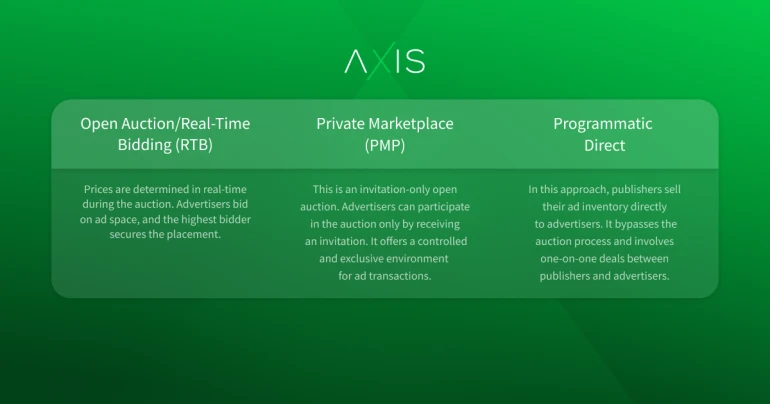
Once, as you enjoyed your favorite TV show, you faced a barrage of irrelevant ads, an advertising approach now seen as outdated but still in use. Nevertheless, the world of advertising never remains stagnant. The world is gradually shifting towards OTT (over-the-top) or CTV in favor of traditional television because these innovative methods are less disruptive and way more profitable. In light of the data, the United States' Connected TV marketing expenditure increased to $8.11 billion in 2020.
In this article, we will delve into the strategic preference for these advertising formats. A key driver for this choice is the burgeoning cord-cutting trend. Marketers have adeptly harnessed this shift to simultaneously reach diverse audiences, save money on the cost per impression, and deliver highly personalized advertisements tailored to individual preferences. But let's take a closer look at this step by step.

CTV Advertising: the Basics
Let's begin by clarifying the difference between Smart TV and Connected TV, where the latter is a more comprehensive concept. Connected TV combines internet and Web 2.0 features to usher in a new era of television. Put simply, CTV fuses computer technology with traditional TV, allowing users to access streaming services like Netflix, Pandora, Hulu, and Apple TV and search the internet for digital content. In short, Connected TV represents a new generation of devices that has won the hearts of millions of users.
We've covered some ground already, right? Now, let's explore the world of CTV Advertising. What's it all about, and how can it work for you? Imagine Connected TV as the heart of your living room – it's got internet smarts, and your CTV ad campaign is your trusted guide to reaching a wide audience. It's like having an open door to a virtual world where everyone's welcome, regardless of their location.
Now, let's provide a detailed explanation of how Connected TV advertising works. First, advertisers define their target audience using a range of data points including demographics, user behavior, and more. This data is primarily sourced from Data Management Platforms (DMPs), cookies, and mobile applications (relevant for mobile CTV viewers).
Subsequently, advertisers proceed to craft tailored ads designed to resonate with their target audience. These ads encompass a variety of formats, spanning from concise video commercials to interactive displays. Following ad creation, advertisers position these ads within CTV apps or streaming services. CTV advertising frequently employs real-time auctions, akin to programmatic advertising. While viewers watch content on their CTVs, ads are seamlessly integrated, appearing either between or within shows. Advertisers commonly incorporate interactive elements, including clickable links and CTAs, to engage viewers. Subsequently, CTV platforms furnish advertisers with comprehensive performance data for individual advertisements, encompassing metrics such as ad impressions, click-through rates, and viewer engagement. This data is utilized to make necessary adjustments to targeting and messaging, enhancing ROI.
Essentially, CTV ads appear on viewers’ screens the same way regular ads do. The only difference is that different viewers will receive different ads based on their preferences and behavior.
Connected TV Statistics
Let's delve into the statistical evidence behind the surging prominence of Connected TV advertising in recent years. With a growing number of Generation Z, millennials, and even baby boomers shifting away from traditional cable television, overlooking investments in this advertising medium would be less than prudent. If your objective is to attain extensive reach while maintaining cost-efficiency, bear in mind that Connected TV advertising represents the trajectory of the future.
- In July 2022, streaming services outpaced cable TV in viewership for the first time. By the end of 2023, it's expected that there will be more "cord-cutters" (those who've ditched cable) than "cord-nevers" (those who never subscribed to traditional cable TV). These numbers show that people are now looking for convenience that traditional cable TV cannot provide.
- 86% of viewers are willing to see ads on their connected TVs, especially if the ads are well-targeted.
- According to Innovid and Digiday's research, 59% of advertisers stated that investing in CTV advertising increased brand awareness.
- CTV advertising spending in the United States was valued at $21.16 billion in 2022.
- CTV allows consumers to access a variety of data sources not available in linear TV purchases, such as first-party brand data (65%), location data (61%), and shopping data (50%).
- From 2.4 in 2017 to 3.9 in 2022, there were on average more Smart or CTV devices.
The Marvel of Connected TV Advertising: Here's Why
Advertisers leverage Connected TV to reach an audience that has shifted away from traditional linear television. By analyzing data like past purchases, website visits, and viewer lifestyles, advertisers can effectively tailor ads to align with the unique preferences of individual users. This approach naturally encourages audience engagement with your brand.
Precise Targeting & Improved ROI
CTV advertisers can increase their return on investment rates by precisely identifying their target audience. In order to view content on their Smart TVs, people need to log in via Facebook or Google accounts, exposing advertisers to an array of useful data required to target the right viewers. A car manufacturer can show its ad to people who have searched for car purchases, while a local organic food shop can reach those who have looked up recipes for making crispy tofu without oil.
Interactive & Unskippable Ads
As a savvy marketer, boosting brand visibility is at your fingertips with the inclusion of a clickable link within your ad. Viewers value convenience and the provision of an immediate link to your product can significantly elevate the likelihood of conversions. Moreover, by making your ad unskippable, you have the opportunity to pique viewers' interest, increasing their engagement and, ultimately, your success in the market. It's a case of striking while the iron is hot!
Cross-Device Reach
CTV ads can be viewed on various devices, including smart TVs, smartphones, and tablets. This cross-device compatibility offers a seamless viewing experience, allowing users to pick up where they left off.
Real-Time Data & Dynamic Content
Based on data on ad performance, marketers can make instant adjustments for better outcomes. If an eCommerce company notices that the CTV traction isn’t sufficient, they can replace the product that will resonate with the audience.
Premium Audience Engagement
Running an ad during primetime while premium content is streaming is one of the best things marketers can do to increase brand awareness and improve ROI. Highly anticipated sports events and concerts featuring popular artists draw in millions of eager viewers. The exposure your brand gains during these events can yield nearly instantaneous positive results.
Programmatic Auctions in the Context of Advertising on Connected TV
Before delving into the intricacies of purchasing ads for Connected TV, it's crucial to gain a clear understanding of the process. In programmatic media buying, there are three primary methods for selling or buying ads:

Why are these methods so effective? Because they use dynamic pricing. Advertisers bid for ad slots, and the one who bids the most gets their ad shown. This way, it keeps the cost of ads in check and makes it cost-effective.
CPM rates for Connected TV
Measuring click counts is not particularly effective in the context of Connected TV advertising, as they can be accurately tracked only for users watching video content on mobile devices. Therefore, it is advisable to rely on CPM rates (Cost Per Mille or Cost Per Thousand) as a more meaningful metric for gauging the success of an advertising campaign.
Connected TV advertising formats typically offer high-quality, full-screen experiences, which can be relatively costly. While the CPM for average video ads typically falls within the range of $10 to $15, CPM rates for Connected TV ads are notably higher, averaging around $65. However, this higher CPM is justified by the reduced cost per view and increased likelihood of viewers watching ads from the beginning to the end.
OTT vs. CTV vs. PTV: Understanding the Differences
Having explored the intricacies and benefits of CTV advertising, let's now delve into distinguishing Connected TV from TV connected with OTT (over-the-top) and Programmatic TV for a comprehensive understanding.
Connected TV
Connected TV opens the door to addressable TV advertising, which means you can enjoy video content on various devices like gaming consoles (PlayStation to Xbox), online TV streaming services, and cable providers. Think of Connected TV as the technology that powers all programmatic TV advertising.
TV connected with OTT (over-the-top)
Unlike connected TV, which is a much broader term, TV connected with OTT (over-the-top) is a traditional TV that has been upgraded to connect to the Internet and have access to streaming content. You can watch your favorite shows via the Internet or stick to old-fashioned cable TV.
Programmatic TV
Programmatic TV is the concept that stands behind showing ads on connected TVs by utilizing specific technologies. It’s a data-driven method that enables buying and delivering ads for TV content. Programmatic TV advertising has brought a transformative shift to the industry. In the past, advertisers sought to place their ads during the commercial breaks of popular shows, relying on high viewership to maximize exposure. However, programmatic TV introduces a more effective approach, enabling the precise targeting of ads to specific viewers based on criteria such as income, lifestyle, age, and more. This tailored approach ensures that ads resonate with the intended audience, enhancing overall campaign effectiveness.
When it comes to programmatic advertising, it's all about making your ad purchases as smooth as possible. In the past, buying ads involved lots of paperwork and negotiations. But with programmatic advertising, marketers now use algorithmic software that acts like a personal assistant and automates many of the processes.
Programmatic advertising buying serves as the vital link between publishers, who possess ad inventory, and advertisers utilizing Demand-Side Platforms (DSPs) to secure ad space through Supply-Side Platforms (SSPs).
Wrapping Up
We hope this guide has given you a peek into the modern advertising landscape, encouraging brands to reevaluate their spending on cable and satellite TV ads. These traditional methods often fall short because audiences aren't as engaged. The numbers speak for themselves. A study by the Pew Research Center shows that in 2015, 65% of people aged 18-29 used cable TV. However, in 2021, that number dropped to 34%. In fact, 61% of all the people surveyed admitted they never used cable TV and instead opted for Smart TVs and other Connected TV devices to watch video content.
Within Axis, you'll discover a dedicated CTV partner ready to guide you through the dynamic world of Connected TV advertising. With our robust network, we offer access to 10 SSPs tailored to this ad format, ensuring your campaigns reach their full potential.